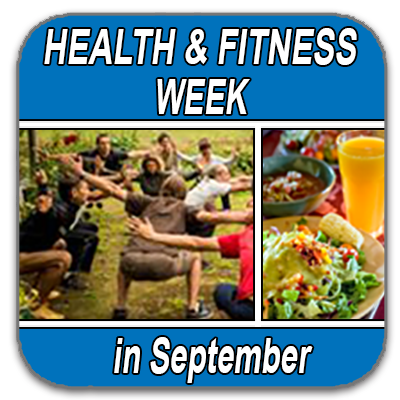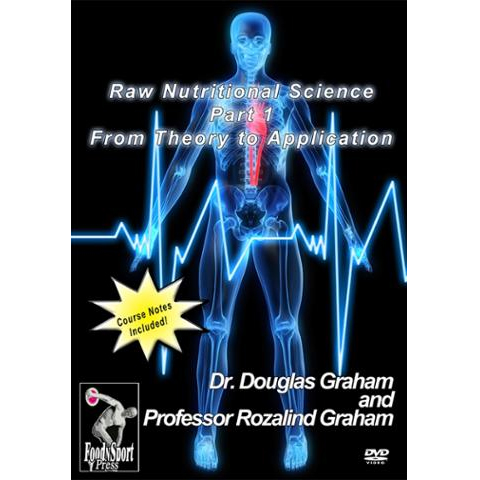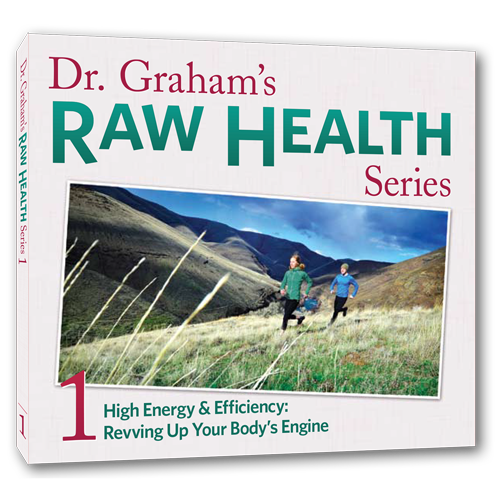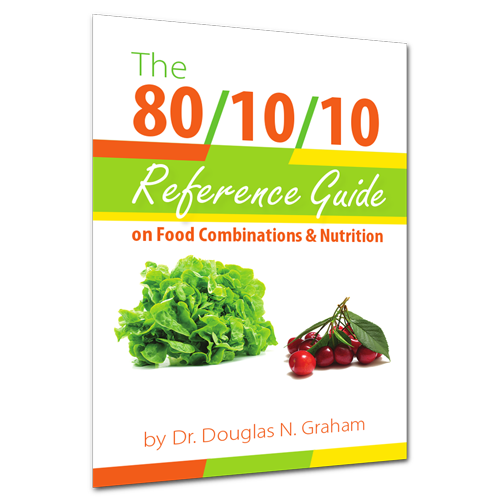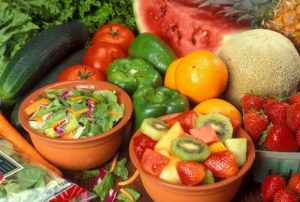
This third part of a five-part interview of Dr. Graham was originally published September 7, 2014, and is reprinted with permission from Ola Huna: Health Secrets Made Simple
80/10/10: Best Foods to Boost Energy and Athletic Performance? (Part 3)
One of the many benefits of a multi-part series like this is that I can drive you crazy – or at least make you keep reading – by withholding key information until the end.
In this case, though, I’m going to do something even better and give away some of it here in Part 3, some of it in Part 4, before the conclusion to the series in Part 5.
Talk about foreplay ![]() This time around, we’re going to turn our attention to protein, nutrition for athletes and more.
This time around, we’re going to turn our attention to protein, nutrition for athletes and more.
We’ll talk about:
- Why we do not need as much protein as we think
- Why meat is a “fat” food, not a “protein” food
- What to eat when you’re training intensively
- Why you can be very fit and very sick (Ever wonder why so many athletes are out due to sickness?)
- What to eat if you have trouble digesting vegetables
Our interviewee Dr. Douglas Graham returns today, with even more tips to share on all of those topics. Let’s get back to it.
Q: What are your thoughts on protein?
Dr. Douglas Graham: I really think protein is a non-issue. Mother’s milk is 6% protein. Babies grow on that limited amount of protein just fine.
The average person in the world eats about 10% to 11% of their calories from protein. I’m recommending 10% as an upper limit. The World Health Organization recommends 3% – 10%, not beyond.
There are very few people eating beyond 10% of their calories from protein, unless they are just absolutely hardcore meat eaters, shunning all other foods. Let’s understand that even meat is not super high in protein.
Meat is super high in fat.
50%, 60%, 70%, 80% of most meats’ calories come from fat. When you’re eating food that’s 80% fat, it is not a high protein food.
Calling meat protein is really a myth. Meat is a fat source more so than a protein source.
Q: So is that why you said people gorge on high protein foods end up with around less than 20% of the calories from protein? Can you elaborate on that?
Dr. Douglas Graham: Butter is almost 100% fat. Oil is 100% fat. If we called oil protein, it would be deceptive.
While there maybe some exceptions, the vast majority of meats sold in stores, have fat content that contributes to 60% – 80% of calories in that food.
To call something that’s 80% fat a protein, is deceptive.
Normally we call the food by its predominating nutrient, so we think of a potato as a carbohydrate because carbohydrate is predominant. There’s protein in potato and there’s fat in potato, but predominantly its carbohydrate.
To look at a hamburger and say “oh, that’s protein” when 75% of the calories are coming from fat, I think that’s deceptive marketing. Hamburgers should be called a fat food.
You’re also going to have it with tomato, and probably a hamburger bun, and some lettuce maybe and an onion ring, and some French fries on the side. All of that makes the meal dominated by carbohydrate and fat, and cuts the protein intake down to about 12%.
Q: Now you talked a lot about working with world class athletes. How would you suggest them to cater 80/10/10 to meet their nutritional requirements, especially if they’re training intensively?
Dr. Douglas Graham: I look at this no different than an animal in nature or your car.
If you have a car, you probably put gasoline in your car. If you drive your car a little, you put in a little gasoline. If you drive your car a lot, you put in a lot of gasoline. You don’t put in different fuel based on how much you drive.
If there’s a cow out in the field, and he’s a relatively small cow that isn’t very active, maybe he’s a musically inclined cow. He’s a poet cow. He doesn’t do a lot. He eats a little bit of grass. And next to him is a very big cow that likes to do a whole lot of physical activity. Well, he eats more grass. But he still just eats grass; it’s a species-specific diet.
For human beings, we have a species-specific diet. This entails fruits and vegetables being our foods.
So if you have an active person, s/he eats more fruits and vegetables. An inactive person eats less fruit and vegetables. But a person eats fruits and vegetables.
Q: In one of your interviews I’ve listened to, you mentioned that some athletes are very fit, but also very sick. Can you talk about that?
Dr. Douglas Graham: I’ve watched the Olympics since I was a little kid. I remember watching the 1960 Olympics, and I’ve never missed the Olympics since then.
The narrators tell us a lot of information about the athletes, I guess maybe as filler, or human interest, or however we want to call it. One of the things they talk about is the various illnesses that athletes have had to overcome.
Eventually I started doing my homework on this, because it interested me, and I realised that athletes in general are very ill. They’re sick people. They’re pushing their limits in many ways. It’s somewhat understandable. But a lot of their illnesses fall into specific categories.
We find actually that the cancer rate among athletes is higher than it is amongst the general population of the same age group individuals.
We think of athletes as adults, but really, our athletes are generally somewhere from mid-teens to 30 or mid-30s. That’s about the end of our athletes.
It’s a rare athlete we see that’s 40 or 50 or 60 years old, competing in anything against the kids. We’re talking about a group of people mostly in their 20s and 30s, who have a higher cancer rate than the general population in their 20s or 30s. They have higher kidney disease. They have a bunch of specific ailments that tend to come on them.
You can only push your physical limits so hard if you don’t support your physiologic requirements. Eventually, something has to fail.
If you’re an athlete consuming a super high fat diet, you’re going to push the limits. Eventually kidneys fail or liver fails.
It’s not common to see a young athlete with heart disease, and that’s understandable. It’s not common to see any young person with heart disease, but we do see that overall, the athletes are sicker.
When we consider overall that athletes eat about triple the amount of food a normal person consume, we can understand that if there are toxins in that food, they’re taking in triple the amount of toxins.
As a result, athletes are stressing their liver and kidneys really hard. If they’re taking in triple the fat, once again, they’re stressing heart and lungs and really pushing it. It’s not surprising that they break down quicker. If you look at, for instance, Tour de France every day, it gives you a list of the athletes that are out due to illness.
Almost all of them are out due to digestive disorders.
And when you are out of the race, you can no longer help your team, and your chance of winning is reduced to zero.
If athletes eat poorly, they end up with digestive disorders. Tour riders eat roughly quadruple what we eat.
Q: What are your tips on how to enhance digestion, other than “eat more fruits and vegetables”?
Dr. Douglas Graham: I understand that it takes some practice and adapting to get used to eating even a small quantity of vegetables if you’re used to eating next to none. It’s like fitness activities. You do have to build up gradually. Actually, many people tell me they have trouble digesting vegetables.
However, it’s a rare individual who tells me they have trouble digesting fruit, and so my first recommendation is to eat all the fruit your care for.
In fact, eat enough fruits so you don’t have any of the common food cravings.
We’ll further elaborate on the all-important “how to deal with cravings” point in the next part.
Stay tuned for updates on the next part of this multi-part interview!
This third part of a five-Part interview of Dr. Graham can be found on Ola Huna: Health Secrets Made Simple by Nicole Lana Lee. Reprinted with permission. Nicole Lana believes that exercise is non-negotiable, and that a nutrient dense, plant-based diet is the cure to many problems, from obesity to cancer to global warming, that we are facing these days. And Ola Huna serves to educate readers and transform their lifestyle gradually, making an impact on your health, as well as the planet’s well being.
Articles:
- Celery: More Than Worth Its Salt by Dr. Graham
- Human Energy by Dr. Graham
- The Caloronutrient Seesaw: How to Succeed Permanently on the Raw-Food Diet by Dr. Graham
- Nutrients: Are You Getting Enough? by Dr. Graham
- Do You Find This Stimulating? by Dr. Graham
Retreats:
Cultivate Your Inner Chef |
Amp Up Your Fitness |
Self-Study Materials:
Raw Nutritional Science: Part 1 (8 DVDs) |
Raw Health Series 1: High Energy & Efficiency |
The 80/10/10 Reference Guide on Food Combining and Nutrition |



